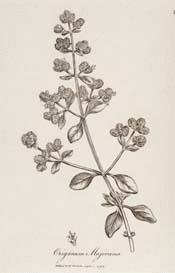
Botanical.com Home Page

|
Sweet Marjoram
(Origanum majorana LINN.)
Click on graphic for larger image
|
Marjoram, Sweet
Botanical: Origanum marjorana (LINN.)
Family: N.O. Labiatae
---Synonyms---Knotted Marjoram. Marjorana hortensis.
---Parts Used---Herb, leaves.
Sweet or Knotted Marjoram is not an annual, but is usually treated as such, as the plants - native to Portugal - will not stand the winter elsewhere, so must be sown every year.
Seeds may be sown, for an early supply, in March, on a gentle hot-bed and again, in a warm position, in light soil, in the open ground during April. Plants do well if sown in April, though they are long in germinating. The seed is small and should be sown either in drills, 9 inches apart, or broadcast, on the surface, trodden, raked evenly and watered in dry weather. On account of the slowness of germination, care should be taken that the seedlings are not choked with weeds, which being of much quicker growth are likely to do so if not destroyed. They should be removed by the hand, until the plants are large enough to use the small hoe with safety. Seed may also be sown early in May. In common with other aromatic herbs, such as Fennel, Basil, Dill, etc., it is not subject to the attacks of birds, as many other seeds are. When about an inch high, thin out to 6 or 8 inches apart each way. It begins to flower in July, when it is cut for use, and obtains its name of Knotted Marjoram from the flowers being collected into roundish close heads like knots.
Marjoram has been cultivated on a small scale at Sfax, Tunis, for a long time, and is called by the natives 'Khezama' (the Arab name for lavender).
Before the War, the herb was bought by agents and exported to Marseilles and other places. The plant is suitable to the sandy soil of the country.
The Marjoram plants are obtained either by division of clumps in winter, or from seeds planted in parallel lines 2 metres apart, between the almond and olive trees; and the soil, being of necessity worked for cultivation of the trees, this also serves to fertilize the Marjoram. One cutting of plant-clumps is best, a second one weakens it. The stems are cut about 10 cms. from the ground, dried in the sun on earth which has been previously beaten slightly. The leaves are separated from the stems by being beaten with staves; they are discoloured by the sun, broken and mixed with the debris of stems of which the odour is less strong.
Drying in the shade obtains more aromatic and less broken leaves, with less impurities.
---Medicinal Action and Uses---The medicinal qualities of the oil extracted from Sweet Marjoram - Oleum majoranae - are similar to that of the Wild Marjoram. Fifteen ounces of the oil are yielded by 150 lb. of the fresh herb. On being kept, it assumes a solid form. It is used as an external application for sprains, bruises, etc., and also as an emmenagogue. In powdered form the herb forms part of certain Sneezing Powders.
---Other Species---In addition to the species just mentioned, others are cultivated in this country as ornamental plants, such as O. Dictamnus, the Dittany of Crete, which has roundish leaves thickly invested with white down, and flowers in drooping spikes; and O. sipyleum, which is similar, but taller and less woolly. These last are popularly called Hop Plants, and are often seen in cottage windows.
RECIPE
Aromatic Herbaceous Seasoning
Take of nutmegs and mace 1 OZ. each, of cloves and peppercorns 2 OZ. of each, 1 OZ. of dried bay-leaves, 3 OZ. of basil, the same of Marjoram, 2 OZ. of winter savoury, and 3 OZ. of thyme, 1/2 OZ. of cayenne pepper, the same of grated lemon-peel, and 2 cloves of garlic; all these ingredients must be well pulverized in a mortar, and sifted through a fine wire sieve, and put away in dry corked bottles for use.
The following is from Halliwell's Popular Rhymes and Superstitions:
- 'On St. Luke's Day, says Mother Bunch, take marigold flowers, a sprig of marjoram, thyme, and a little wormwood; dry them before a fire, rub them to powder, then sift it through a fine piece of lawn, and simmer it over a slow fire, adding a small quantity of virgin honey and vinegar. Anoint yourself with this when you go to bed, saying the following lines three times, and you will dream of your future partner "that is to be":
- St. Luke, St. Luke, be kind to me,
- In dreams let me my true love see.
- If a girl desires to obtain this information, let her seek for a green peascod in which there are full 9 peas, and write on a piece of paper -
- Come in, my dear,
- And do not fear;
- which paper she must enclose in the peascod,and lay it under the door. The first person who comes into the room will be her husband.'
Shakespeare may allude to this in As You Like It (ii. iv.) when he talks about the wooing of a peascod.
[Top]
Common Name Index
A MODERN HERBAL Home Page
Bear in mind "A Modern Herbal" was written with the conventional wisdom of the early 1900's. This should be taken into account as some of the information may now be considered inaccurate, or not in accordance with modern medicine.
© Copyright Protected 1995-2025 Botanical.com
|

